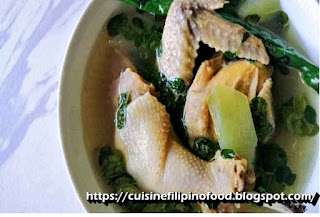"Tinolang Manok" is a popular Filipino dish known for its comforting and flavorful chicken soup infused with ginger and vegetables. Here's some detailed information you can include in your blog post:
Origin and Background:
Tinolang Manok is a traditional Filipino dish that has been passed down through generations. Its roots can be traced back to Filipino home kitchens, where it is often prepared for family meals, especially during cold or rainy weather. The dish's simplicity and heartiness make it a beloved comfort food in Filipino cuisine.
- Chicken: Traditionally, free-range chicken is preferred for its richer flavor, but any chicken parts can be used.
- Ginger: Fresh ginger is a key ingredient that provides a warm and aromatic flavor to the broth.
- Garlic: Adds depth of flavor to the soup base.
- Onion: Typically used to sauté with garlic and ginger as the base of the soup.
- Chili leaves or spinach: These leafy greens are added towards the end of cooking for freshness and color.
- Green papaya or chayote: Sliced into wedges or cubes, these vegetables provide texture and additional flavor to the soup.
- Fish sauce (patis): A staple condiment in Filipino cuisine, fish sauce adds a savory umami flavor to the soup.
- Water or chicken broth: Forms the base of the soup.
Preparation:
- Sauteing Aromatics: Begin by sautéing garlic, ginger, and onions in a pot until fragrant.
- Adding Chicken: Add the chicken pieces to the pot and cook until lightly browned.
- Pouring Liquid: Pour water or chicken broth into the pot, enough to cover the chicken, and bring to a boil.
- Simmering: Once boiling, reduce the heat to a simmer and let the chicken cook until tender.
- Adding Vegetables: Add the green papaya or chayote and cook until they are tender but still crisp.
- Seasoning: Season the soup with fish sauce according to taste.
- Adding Greens: Finally, add chili leaves or spinach and cook until wilted.
Serving:
Variations:
- Tinolang Manok sa Malunggay: Some recipes incorporate malunggay (moringa) leaves for added nutritional value.
- Tinolang Manok with Coconut Milk: In some regions, coconut milk is added to the broth for a richer flavor.
Cultural Significance:
Tinolang Manok is not only a delicious dish but also a symbol of Filipino hospitality and family bonding. It is often prepared for gatherings and special occasions, showcasing the warmth and generosity of Filipino culture.
Health Benefits:
- Tinolang Manok is a nutritious dish packed with protein from the chicken and vitamins from the vegetables.
- The ginger used in the soup is known for its anti-inflammatory and digestive properties.
- The addition of leafy greens provides essential nutrients and fiber.
- Here are some additional aspects you can include in your blog post about Tinolang Manok:
Regional Variations:
- Visayan Tinola: In the Visayan region of the Philippines, Tinola may include additional ingredients such as lemongrass or lemongrass leaves for added aroma and flavor.
- Ilocano Tinola: In the Ilocos region, Tinola may be cooked with fermented fish sauce (bagoong) instead of regular fish sauce, giving it a unique savory taste.
- Bicol Express Tinola: Inspired by the spicy Bicol Express dish, some variations of Tinola may incorporate chili peppers or coconut milk for a richer and spicier flavor profile.
Seasonal Adaptations:
- Tinolang Manok sa Patis: During the Lenten season or on meatless days, Tinola can be prepared using patis (fish sauce) as a substitute for chicken, providing a flavorful alternative for vegetarians.
- Tinolang Manok sa Munggo: Another variation combines Tinola with mung beans (munggo), creating a hearty and nutritious stew perfect for cooler months.
Family Traditions:
- Share personal anecdotes or family traditions related to Tinolang Manok, such as memories of cooking the dish with loved ones or special occasions where it was served.
- Discuss how Tinola recipes may vary from one family to another, with each household adding its own unique twist or secret ingredient.
Pairing Suggestions:
- Offer suggestions for side dishes or accompaniments that complement Tinolang Manok, such as crispy fried fish, pickled vegetables, or a simple salad with vinegar dressing.
- Recommend beverages that pair well with Tinola, such as calamansi juice or a cold glass of iced tea.
Cooking Tips:
- Provide cooking tips and tricks for achieving the best results when making Tinolang Manok, such as how to properly clean and prepare the chicken, or techniques for extracting maximum flavor from the ginger and aromatics.
- Offer suggestions for ingredient substitutions or modifications to suit dietary preferences or restrictions.
Historical and Cultural Context:
- Delve into the historical and cultural significance of Tinolang Manok, exploring its roots in Filipino cuisine and its evolution over time.
- Discuss how the dish reflects Filipino values of resourcefulness, hospitality, and communal dining traditions.
Visual Inspiration:
- Include high-quality photographs or videos showcasing the preparation process and final presentation of Tinolang Manok, enticing readers with its vibrant colors and appetizing appeal.
- Encourage readers to share their own photos or experiences with Tinola on social media using a designated hashtag.
By incorporating these additional elements into your blog post, you can create a comprehensive and engaging resource that celebrates the rich culinary heritage of Tinolang Manok and its cultural significance in Filipino cuisine.
Conclusion:
Tinolang Manok is more than just a soup; it's a reflection of Filipino culinary heritage and values. Whether enjoyed on a rainy day or served during celebrations, this dish brings people together with its comforting flavors and nourishing ingredients.


.jpg)
Comments
Post a Comment